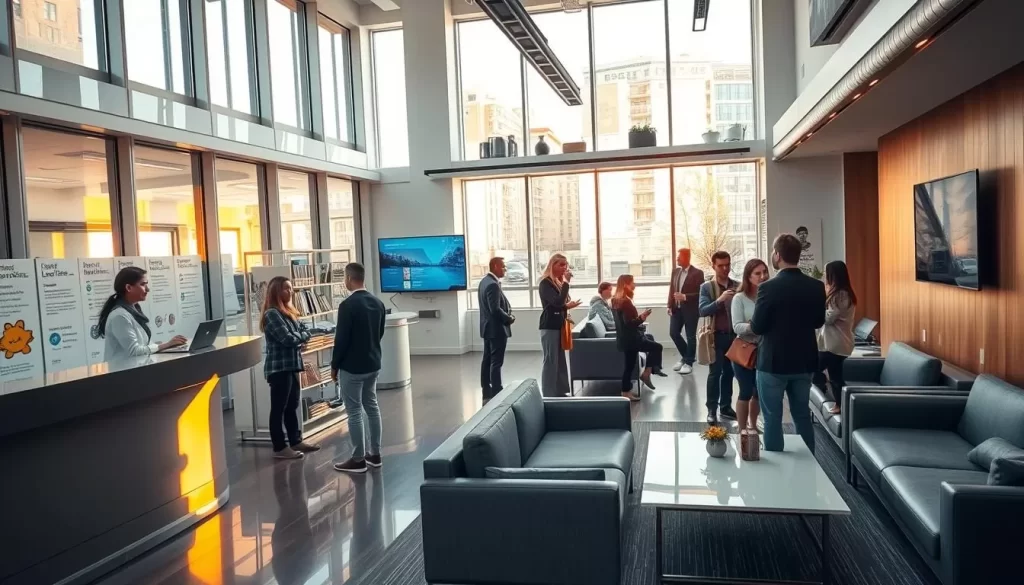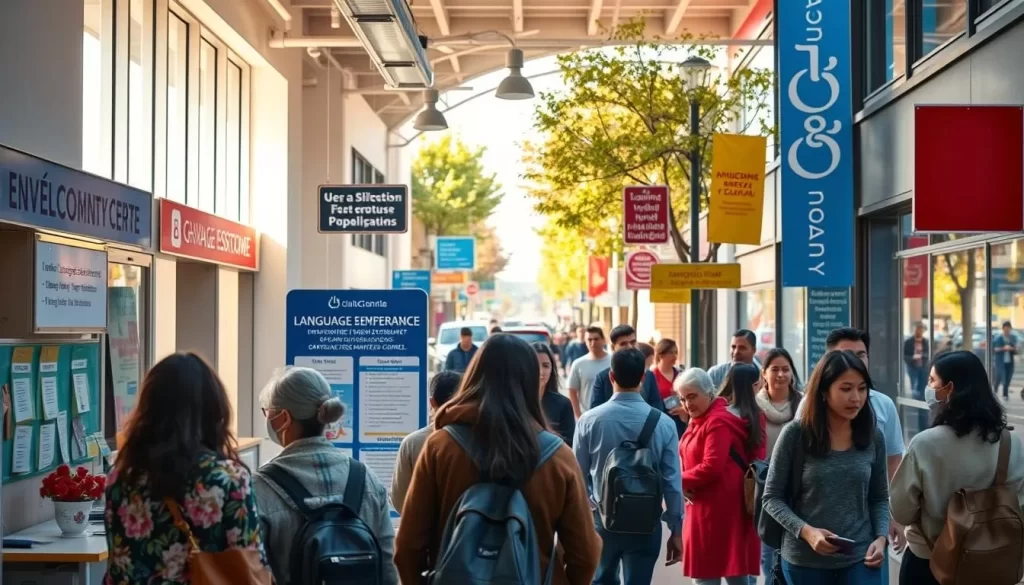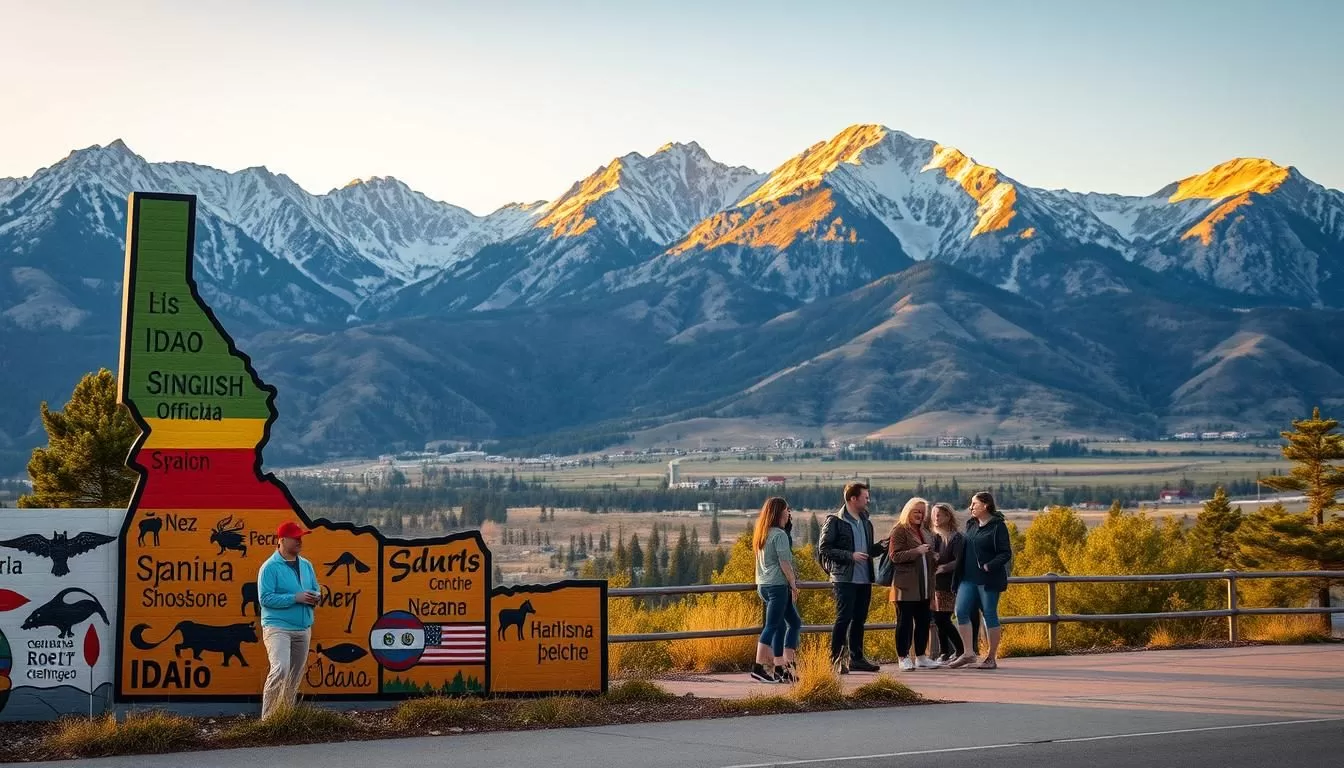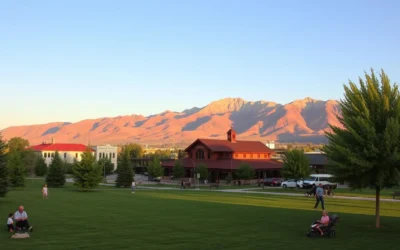✓ Accommodations ✓ Flights ✓ Rental Cars
As you explore the Gem State, you’ll discover a diverse linguistic landscape. Located in the Pacific Northwest region of the United States, Idaho is home to a multitude of languages.
English is the official language of Idaho, established through legislation to ensure clear communication across the state. Despite this, Idaho’s population is diverse, with a mix of cultures and languages spoken.
This diversity is reflected in the various communities found throughout the state, with significant numbers of Spanish speakers and smaller groups speaking Native American, Asian, and European languages. Understanding this linguistic diversity is crucial for cultural appreciation and effective communication within Idaho.
This article will explore the different languages spoken in Idaho, their historical context, and their current status, providing you with a deeper understanding of the state’s linguistic landscape.
The Linguistic Landscape of Idaho
As you explore the diverse regions of Idaho, you’ll discover a complex linguistic landscape shaped by its demographic characteristics. With a population of approximately two million people, Idaho ranks as the 13th-least populous and the seventh-least densely populated of the 50 U.S. states. This demographic overview sets the stage for understanding the state’s language diversity.
Idaho’s Demographic Overview
Idaho’s population is distributed across urban and rural areas, with cities like Boise and Idaho Falls having larger concentrations of people. The state’s demographic characteristics, including age, ethnicity, and socioeconomic status, influence the languages spoken at home. You can see a reflection of this diversity in the various languages used in different communities across the state.
The U.S. Census Bureau collects data on language use, providing insights into the linguistic diversity of Idaho’s population. According to this data, a significant percentage of Idaho residents speak languages other than English at home, a trend that is also observed nationally. However, the specific languages spoken vary significantly across different regions of the state.
Language Diversity in the Gem State
Idaho’s nickname, the “Gem State,” reflects not only its rich mineral resources but also the diverse cultural and linguistic treasures found within its borders. You will find that different areas of the state have distinct language profiles, influenced by factors such as economic sectors, cultural events, and the presence of educational institutions.
In urban areas and university communities, there tends to be greater linguistic variety, with languages such as Spanish, Chinese, and other Asian languages being spoken alongside English. The technology, tourism, and agriculture sectors also contribute to the state’s language diversity, as people from various linguistic backgrounds interact and conduct business.
Recent trends in language diversity show that some language communities are growing, while others are declining in different parts of the state. For instance, the Hispanic population has been growing in certain areas, leading to an increase in Spanish language use. Understanding these trends is crucial for providing language access services and supporting the state’s diverse communities.
English: Idaho’s Official Language
As you explore the linguistic landscape of Idaho, you’ll find that English plays a pivotal role in the state’s language dynamics. English is not only the official language but also the most widely spoken language in the state. Understanding the role of English in Idaho involves examining its legal status, language policy, and demographics.
Legal Status and Language Policy
English has been designated as the official language of Idaho, reflecting its importance in government, education, and daily life. The state’s language policy supports the use of English in official capacities, ensuring that government services, public education, and other essential services are accessible to the majority of the population.
The legal status of English in Idaho is clear: it is the language used by the state government for all official purposes. This includes government meetings, official documents, and public services. The state’s adherence to English as the official language is consistent with the majority of the U.S., where English is the predominant language.
Idaho’s language policy also impacts education, with English being the primary language of instruction in public schools. This policy ensures that students are proficient in English, enabling them to participate fully in the state’s economy and society.
Furthermore, the state’s language policy influences the way government services are delivered. For instance, public health information, emergency services, and government forms are typically provided in English. This ensures that the majority of the population can access these services without language barriers.
English Language Demographics in Idaho
According to the American Community Survey (ACS) of the U.S. Census Bureau, as of 2023, the majority of the U.S. population (78%) speaks only English at home. In Idaho, this percentage is likely even higher, reflecting the state’s demographic characteristics.
Data from the United States Census and the ACS provide insights into English language usage in Idaho. The percentage of Idaho residents who speak only English at home is likely higher than the national average, indicating a strong presence of English in the state.
Analyzing variations in English proficiency across different demographic groups and geographic regions within Idaho reveals interesting trends. For instance, English proficiency can vary among different age groups, with younger populations generally having higher proficiency levels.
The prevalence of different American English dialects in Idaho, including regional accents and vocabulary, adds to the state’s linguistic diversity. While the majority speaks English, there are nuances in how it is spoken across different parts of the state.
Examining trends in English language usage over time shows that while English remains the dominant language, there are shifts in language demographics due to demographic changes.
The relationship between English language proficiency and socioeconomic factors in Idaho is significant. Proficiency in English is often linked to better economic opportunities, education, and healthcare outcomes.
English language demographics have a direct influence on education, business, and government services in Idaho. The predominance of English ensures that these services are primarily delivered in English, shaping the way institutions operate.
Looking ahead, the future trajectory of English language usage in Idaho is likely to be shaped by current demographic trends. As the state’s population evolves, so too will the linguistic landscape.
Spanish: The Second Most Spoken Language
As you explore the linguistic landscape of Idaho, you’ll discover that Spanish plays a significant role as the second most spoken language. This presence is not merely a reflection of recent demographic changes but is rooted in a complex history that spans centuries. The state’s linguistic diversity is shaped by various factors, including historical migration patterns, cultural exchange, and economic needs.
Spanish-Speaking Communities in Idaho
Spanish-speaking communities in Idaho are vibrant and diverse, contributing significantly to the state’s cultural and economic fabric. You can find these communities in various parts of the state, from urban centers like Boise to rural areas where agricultural labor is a mainstay.
The presence of Spanish-speaking people is particularly notable in the agricultural sector, where they have been integral to the workforce for decades. This presence is a result of various factors, including the Bracero Program, which between 1942 and 1964 brought Mexican workers to the United States to work on farms and railroads.
Over time, many of these workers settled in Idaho, establishing permanent communities. Today, you can see the legacy of this migration in the many Hispanic cultural events, businesses, and media outlets that serve these communities.
The establishment of permanent Hispanic communities has been accompanied by the growth of Spanish language media, including newspapers, radio stations, and television programs. These media outlets play a crucial role in serving the information needs of Spanish-speaking populations.
| County | Spanish-Speaking Population (%) | Main Industries |
|---|---|---|
| Boise County | 15% | Agriculture, Tourism |
| Payette County | 20% | Agriculture, Manufacturing |
| Canyon County | 25% | Agriculture, Retail |
Historical Context of Spanish in Idaho
The historical context of Spanish in Idaho is complex, reflecting the state’s position within the broader region. The influence of Spanish colonization in the region, including areas that are now neighboring states, has had a lasting impact on Idaho’s linguistic development.
Historically, the presence of Spanish in the region dates back to the early exploration and settlement periods. Although Idaho was not directly a part of the Spanish colonial empire, the language and culture were introduced through the activities of explorers, missionaries, and traders.
The Bracero Program and subsequent agricultural labor patterns significantly influenced the presence of Spanish in Idaho. Many workers who came under the program stayed, contributing to the growth of Spanish-speaking communities.
Understanding the historical context helps you appreciate the nuances of Idaho’s linguistic landscape. The state’s experience with Spanish is distinct from that of states with longer Hispanic histories, such as New Mexico or California.
In conclusion, the presence of Spanish as the second most spoken language in Idaho is a reflection of the state’s diverse cultural heritage and its historical connections to broader regional and global trends.
Idaho, United States: Official and widely spoken languages Statistics
Idaho’s language statistics reveal a complex tapestry of linguistic diversity across the state. As you explore the linguistic landscape of Idaho, you’ll find that the distribution of languages varies significantly across different counties.
Language Distribution by County
The distribution of languages in Idaho is not uniform, with different counties exhibiting unique linguistic profiles. According to the American Community Survey, the percentage of non-English speakers varies significantly across the state.
- In Ada County, which includes the state capital Boise, Spanish is the most common non-English language spoken at home.
- In contrast, counties like Clark and Jefferson have a higher percentage of residents speaking Native American languages.
- The presence of Asian languages is more pronounced in urban areas like Canyon County.
Here’s a snapshot of language distribution in some of Idaho’s counties:
| County | Most Common Non-English Language | Percentage of Non-English Speakers |
|---|---|---|
| Ada | Spanish | 15% |
| Clark | Native American Languages | 20% |
| Canyon | Asian Languages | 10% |
Language Trends Over Time
Analyzing language trends over time in Idaho reveals significant shifts in the linguistic landscape. Historical data from the United States Census and American Community Survey show that the percentage of non-English speakers in Idaho has been increasing since the 1980s.
Some key trends include:
- A significant growth in Spanish speakers, driven by immigration and higher birth rates.
- The emergence of newer language communities, such as Arabic, Swahili, and Nepali, due to refugee resettlement.
- Changes in Native American language usage, with both preservation efforts and declining speaker numbers.
As you examine these trends, it becomes clear that Idaho’s linguistic diversity is shaped by a combination of factors, including economic changes, immigration patterns, and demographic shifts. By understanding these trends, you can better appreciate the complex linguistic landscape of Idaho.
Native American Languages in Idaho
Native American languages in Idaho are not just a relic of the past; they are living, breathing aspects of the state’s identity. Idaho has been home to numerous Native American tribes, each with their own distinct language and cultural practices. The predominant American Indian peoples in the area have included the Nez Percé in the north and the Northern and Western Shoshone in the south.
Nez Perce (Nimipuutimt)
The Nez Perce language, also known as Nimipuutimt, is spoken by the Nez Perce people. It is a Sahaptian language, part of the larger Penutian language family. Historically, Nimipuutimt was widely spoken across the region that now includes parts of Idaho, Oregon, and Washington. Despite the challenges faced by Native American languages, including colonization and forced assimilation policies, efforts have been made to document and preserve Nimipuutimt.
The Nez Perce tribe has been actively involved in language preservation, including the development of language education programs. These initiatives aim to teach Nimipuutimt to both children and adults, ensuring the language continues to be a vital part of Nez Perce cultural identity.
Shoshone and Bannock Languages
The Shoshone and Bannock tribes, while distinct, share cultural and linguistic ties. The Shoshone language belongs to the Numic branch of the Uto-Aztecan language family. There are different dialects of Shoshone, with variations spoken across different regions. The Bannock language is closely related to Shoshone, and some sources consider it a dialect of Shoshone.
Language preservation efforts among the Shoshone and Bannock peoples include language documentation projects, where linguists work with native speakers to record and analyze the language. Additionally, cultural camps and language immersion programs have been established to promote the use of Shoshone and Bannock languages among younger generations.
Preservation Efforts for Indigenous Languages
Preserving Native American languages in Idaho involves a multifaceted approach, including tribal, state, and federal initiatives. The Native American Languages Act of 1990 has been instrumental in promoting the preservation and revitalization of Native American languages. This legislation recognizes the importance of Native American languages to the cultural identity and heritage of Native American communities.
Universities and colleges in Idaho play a crucial role in supporting indigenous language documentation, teaching, and research. They provide resources and expertise that are essential for the development of language programs and the training of language teachers.
Innovative approaches to language revitalization include master-apprentice programs, where fluent speakers are paired with learners; language nests, which are early childhood education programs conducted entirely in the Native American language; and immersion schools, where students receive a significant portion of their education in the Native language. Digital technologies, including language learning apps and online resources, are also being utilized to support language preservation.
| Language | Tribal Community | Preservation Efforts |
|---|---|---|
| Nimipuutimt (Nez Perce) | Nez Perce Tribe | Language education programs, documentation |
| Shoshone | Shoshone Tribe | Language documentation, cultural camps |
| Bannock | Bannock Tribe | Language immersion programs, cultural events |
Despite these efforts, challenges persist, including limited resources, aging speaker populations, and competing priorities within Native American communities. However, the psychological and social benefits of language revitalization are significant, contributing to strengthened identity and cultural continuity among Native communities.
Asian Languages in Idaho
You might be surprised by the array of Asian languages spoken in Idaho, a state known for its natural beauty. The presence of these languages reflects the diverse cultural fabric of the state, shaped by historical migration patterns, refugee resettlement, and international connections.
Chinese Language Communities
The Chinese language has a significant presence in Idaho, with various communities contributing to the state’s cultural diversity. Chinese speakers have been part of Idaho’s demographic landscape for decades, with many originally coming as workers or immigrants. Today, you can find Chinese language schools, cultural events, and community organizations that support the Chinese-speaking population. These institutions play a crucial role in maintaining the language and cultural heritage of the community. As of the latest data, the Chinese community remains one of the larger Asian language groups in Idaho.
Vietnamese Speakers in Idaho
Vietnamese is another significant Asian language spoken in Idaho. The Vietnamese community in Idaho has grown over the years, with many originally coming as refugees. The community has established various cultural institutions, including religious centers and community organizations, which support the language and cultural practices. You can find Vietnamese language schools and cultural events that celebrate Vietnamese heritage. The presence of Vietnamese speakers adds to the linguistic diversity of Idaho, contributing to the state’s multicultural identity.
Other Asian Languages
Beyond Chinese and Vietnamese, Idaho is home to a variety of other Asian languages. According to data from the Migration Policy Institute, there are 767 Korean speakers, 562 Tagalog speakers, and 395 Japanese speakers in Idaho. These communities, though smaller, contribute significantly to the state’s linguistic diversity. The historical context of each language community’s presence in Idaho varies, from Japanese agricultural workers in the early 20th century to more recent refugee resettlement from Nepal and Bhutan.
The demographic characteristics of these language communities, including their size, geographic distribution, and growth trends, vary. For instance, some communities are concentrated in urban areas like Boise, while others are more dispersed. Cultural institutions such as community organizations, religious centers, and cultural events play a vital role in supporting these languages.
Despite their contributions, smaller language communities face unique challenges in maintaining their linguistic and cultural connections. However, digital technology and global connections have made it easier for these communities to maintain their heritage despite geographic isolation.

The relationship between international business, education, and military connections has also brought speakers of various Asian languages to Idaho. Refugee resettlement programs in Boise and Twin Falls have further contributed to the diversity of Asian languages in the state. As a result, Idaho’s linguistic landscape is enriched by the presence of these languages, reflecting the state’s connection to global cultures and communities.
European Languages Beyond English
Beyond English, Idaho’s population speaks a range of European languages, contributing to the state’s rich cultural tapestry. This diversity is a result of historical migration patterns, refugee resettlement programs, and contemporary connections with European countries.
German-Speaking Communities
German-speaking communities have a notable presence in Idaho. The state’s history with German immigration dates back to the late 19th century, with many Germans settling in the rural areas. Today, you can still find communities that maintain their German heritage through cultural events and language preservation efforts.
Demographic Characteristics: The German-speaking population is primarily located in the Boise area and other urban centers. According to demographic data, there is a significant number of people with German ancestry, making it one of the largest European language groups in the state.
Cultural Institutions: Organizations such as the Boise German American Society play a crucial role in maintaining the German language and culture. They organize cultural events, language classes, and festivals that celebrate German heritage.
French Language Presence
The French language has a smaller but still significant presence in Idaho. The historical context of French in Idaho is tied to the early explorers and missionaries who came to the region. While the number of native French speakers is relatively low, there are efforts to maintain the language through education and cultural activities.
- French language classes are offered in some schools and colleges.
- Cultural events, such as French film screenings and cultural festivals, are organized by the French Alliance.
- There are also efforts to preserve the language through language exchange programs.
Community Engagement: The French community in Idaho engages in various activities to promote the language and culture. This includes participating in international French events and hosting French-themed events.
Other European Languages
Idaho is home to a variety of other European languages, including Russian, Ukrainian, Romanian, and Serbo-Croatian. The presence of these languages is largely due to refugee resettlement programs and immigration.
Data from the Migration Policy Institute indicates that there are 481 Russian speakers, 245 Ukrainian speakers, 315 Romanian speakers, and 815 Serbo-Croatian speakers in Idaho. These communities have formed cultural organizations and churches that support language maintenance.
| Language | Number of Speakers |
|---|---|
| Russian | 481 |
| Ukrainian | 245 |
| Romanian | 315 |
| Serbo-Croatian | 815 |
The presence of these languages is not only a reflection of the state’s diverse population but also a result of the connections between Idaho and European countries through business, education, and tourism. As the population continues to evolve, the linguistic diversity is likely to grow, making Idaho a culturally rich and diverse place to live.
Language Education in Idaho
You can find various language learning initiatives in Idaho, reflecting the state’s commitment to linguistic diversity. Language education is a vital part of Idaho’s educational system, catering to the needs of both schools and adult learners. The state’s approach to language education is multifaceted, encompassing both formal schooling and adult education.
Foreign Language Programs in Schools
Idaho’s schools offer a range of foreign language programs designed to equip students with the skills needed in an increasingly globalized world. These programs are tailored to different age groups and proficiency levels, ensuring that students receive appropriate instruction.
Many schools in Idaho have incorporated languages such as Spanish, French, and German into their curricula. The inclusion of these languages not only enhances students’ linguistic abilities but also fosters cultural understanding and appreciation.
Elementary schools in Idaho have started to introduce language instruction to lay the foundation for future learning. This early exposure helps students develop a keen interest in languages and cultures.
High School Language Programs
High schools in the state offer more advanced language courses, often with a focus on practical application and cultural immersion. These programs are designed to prepare students for further education or careers that require language proficiency.
Adult Language Learning Resources
Idaho provides a variety of language learning resources for adults, including community college courses, university extension programs, and continuing education options. These resources cater to the diverse needs of adult learners, from those seeking personal enrichment to those requiring language skills for professional advancement.
Many organizations in Idaho offer English as a Second Language (ESL) programs, which are crucial for the state’s immigrant and refugee populations. These programs are designed to enhance language access and facilitate integration into the community.
Libraries, community centers, and nonprofit organizations play a significant role in providing language learning resources to adults. They offer a range of services, including language classes, conversation groups, and cultural events.
The use of online and digital resources has become increasingly important for language learning in Idaho, especially for residents in rural areas. These resources provide flexible learning opportunities that cater to different schedules and learning styles.
Some businesses and employers in Idaho support language learning among their workforce, recognizing the benefits of a multilingual team. This support can include language training programs and education services.
Language Access Services in Idaho
With its multicultural population, Idaho requires robust language access solutions to ensure that all residents can access essential services. Language access services are vital in bridging the communication gap between service providers and the diverse communities they serve.
Government Services in Multiple Languages
Idaho’s government recognizes the importance of providing services that cater to its linguistically diverse population. Government agencies have implemented various measures to ensure that language access is not a barrier to accessing public services. For instance, many government websites are now available in multiple languages, and public offices provide interpretation services for individuals with limited English proficiency.
The state’s efforts to enhance language access include:
- Providing translated materials for key government services
- Training government employees in language access policies and practices
- Partnering with community organizations to reach linguistically isolated populations
These initiatives are crucial in ensuring that all Idaho residents can access government services without facing language barriers.

Healthcare and Legal Translation Services
Healthcare and legal services are critical areas where language access is paramount. In healthcare, providers across Idaho are addressing language barriers by employing medical interpreters and translators to serve patients with limited English proficiency. Federal law mandates that healthcare facilities receiving federal funding provide language access services, and Idaho facilities have implemented various strategies to comply with these requirements.
The availability of medical interpreters and translators varies across different regions of Idaho, with urban areas generally having better access to these services than rural areas. Innovative approaches, such as video remote interpreting and multilingual health education materials, are being adopted to improve healthcare outcomes for linguistically diverse populations.
In the legal system, Idaho courts provide court interpreters and translated documents to ensure that individuals with limited English proficiency can navigate the legal system effectively. Legal aid organizations also offer multilingual services to support those in need.
Despite these efforts, challenges persist, particularly in providing specialized medical and legal interpretation in less commonly spoken languages. Ensuring that interpreters and translators are professionally trained and certified is crucial for maintaining the quality of language services.
Idaho’s English-Only Movement
As you explore Idaho’s language policy, you’ll find the English-only movement playing a crucial role. This movement has shaped the way the state government approaches language use in official contexts.
History of Language Policy Legislation
Idaho has declared English as its official language. The history of this legislation is rooted in the early 2000s when there was a nationwide push towards English-only policies. In 2006, Idaho passed a law making English the official language of the state.
The legislation was driven by concerns about the integration of non-English speaking communities. Proponents argued that an official language would promote unity and simplify government services.
The impact of this law has been significant, affecting various aspects of government services and public life.
| Year | Legislation | Impact |
|---|---|---|
| 2006 | English declared official language | Simplified government services |
| 2010 | Amendments to the 2006 law | Enhanced enforcement |
| 2015 | Expansion of language access services | Increased accessibility for non-English speakers |
Public Opinion and Controversy
Public opinion on Idaho’s English-only movement is divided. Some people support the policy, citing the importance of a common language for communication. Others oppose it, arguing that it marginalizes non-English speaking communities.
The controversy surrounding the English-only movement reflects broader cultural and political divisions within the state. Advocacy groups on both sides have shaped the public conversation about language policy.
Analyzing polling data reveals a complex picture of public opinion. While some surveys indicate strong support for English-only policies, others highlight concerns about the impact on language diversity.
The debate over language policy in Idaho continues, with various stakeholders, including educators, government officials, and community advocates, contributing to the discussion.
Language and Cultural Identity in Idaho
Language plays a pivotal role in shaping Idaho’s cultural identity. The state’s diverse linguistic landscape is a reflection of its rich cultural heritage. As you explore the various languages spoken in Idaho, you’ll discover how they contribute to the state’s unique cultural fabric.
Preserving Language and Cultural Heritage
Preserving language is crucial for maintaining cultural heritage. In Idaho, efforts to preserve indigenous languages, such as Nez Perce and Shoshone, are underway. These indigenous languages are an integral part of the state’s cultural identity. Community programs and language education initiatives are being implemented to ensure the continuation of these languages.
The role of religious institutions in language maintenance is also significant. Many religious institutions in Idaho serve as centers for language preservation, offering services and activities in various languages. This not only helps maintain linguistic diversity but also fosters a sense of community among the diverse populations.
| Language | Preservation Efforts | Community Involvement |
|---|---|---|
| Nez Perce | Language education programs | High |
| Shoshone | Community language classes | Moderate |
| Spanish | Cultural events and festivals | High |
Linguistic Communities and Cultural Events
Idaho’s linguistic diversity is celebrated through various cultural events and festivals. These events provide a platform for different linguistic communities to come together and share their cultural heritage. You can experience the vibrant cultural scene in Idaho by attending events that showcase the state’s linguistic diversity.
Cultural arts, including music, dance, literature, and theater, play a significant role in supporting language preservation and expression. These art forms help to keep languages alive and vibrant, while also promoting cultural understanding and appreciation among the people of Idaho.
The economic and tourism value of cultural events that showcase Idaho’s linguistic diversity should not be overlooked. These events attract visitors from various areas, contributing to the local economy and promoting cultural exchange.
Language Challenges for Idaho’s Immigrant Population
Idaho’s immigrant population faces unique language challenges that impact their daily lives and integration into the community. As the state’s demographic landscape continues to evolve, understanding these challenges becomes increasingly important for policymakers, service providers, and the community at large.
Limited English Proficiency Demographics
Over 8% of the U.S. population has limited English proficiency (LEP), a figure that translates to significant numbers in Idaho. This demographic faces numerous challenges in accessing essential services, finding employment, and fully participating in their communities. In Idaho, the LEP population is diverse, comprising individuals from various language backgrounds and countries of origin.
The data on LEP individuals in Idaho reveals a complex picture. Many industries often overlook this group of over 25 million people nationwide, and Idaho is no exception. The language barrier can significantly hinder their ability to access healthcare, education, and legal services, among other essential needs.
| Language Spoken | Percentage of LEP Population | Primary Areas of Residence |
|---|---|---|
| Spanish | 65% | Boise, Twin Falls, Pocatello |
| Other Indo-European Languages | 20% | Boise, Idaho Falls, Meridian |
| Asian and Pacific Island Languages | 15% | Boise, Nampa, Caldwell |
Support Systems and Resources
Despite the challenges, there are various support systems and resources available to help Idaho’s immigrant population overcome language barriers. Communities across the state offer a range of programs and services designed to support LEP individuals.
English as a Second Language (ESL) programs are crucial for adult immigrants. These programs are available in various communities and are often tailored to meet the specific needs of different language groups. Nonprofit organizations, faith communities, and ethnic associations also play a vital role in providing language support and cultural orientation.
Innovative programs that combine language learning with other essential services, such as job training, healthcare access, or childcare, are particularly effective. Idaho’s refugee resettlement programs also address language barriers for newly arrived refugees, providing them with the necessary tools to integrate into society.

Digital and technological resources are increasingly important in supporting language learning and access for immigrant populations. Online platforms, mobile apps, and digital literacy programs help bridge the gap for those with limited English proficiency. Moreover, immigrant-owned businesses and ethnic enclaves provide linguistic support and cultural familiarity for newcomers, creating welcoming communities.
While there are numerous support systems in place, there are still gaps in the current system. Additional resources and services are needed across different regions of Idaho to fully address the needs of the LEP population. By understanding these needs and working together, Idaho can create a more inclusive environment for all its residents.
The Impact of Technology on Language Use in Idaho
The rise of digital technology has significantly impacted language use in Idaho, opening up new avenues for language learning and community building. As you explore the ways technology is influencing language, you’ll find that it’s not just about accessing information; it’s about connecting people and fostering language communities.
Digital Resources for Language Learning
Digital technology has revolutionized the way people in Idaho learn new languages. Online courses, language learning apps, and digital resources have made it easier for individuals to acquire language skills at their own pace. You can now access a plethora of language learning materials, from interactive lessons to language exchange platforms, all from the comfort of your home.
Some of the popular digital resources include language learning apps like Duolingo, Babbel, and Rosetta Stone. These platforms offer comprehensive lessons, quizzes, and exercises tailored to different learning styles. Moreover, online communities and forums provide support and practice opportunities for language learners.
| Resource | Description | Accessibility |
|---|---|---|
| Duolingo | Interactive language lessons | Free, with ads |
| Babbel | Comprehensive language courses | Subscription-based |
| Rosetta Stone | Structured language learning | Subscription-based |
Social Media and Language Communities
Social media platforms have become vital for language maintenance and community building among Idaho’s diverse linguistic populations. You can join language-specific groups on Facebook, follow language learning influencers on Instagram, or participate in language exchange on Twitter. These online communities connect you with others who share your language interests or proficiency.
For instance, Idaho’s Spanish-speaking communities use social media to maintain their linguistic connections. They share cultural content, participate in language challenges, and engage in discussions that promote the use of Spanish. Similarly, other language communities, including those speaking Native American languages, use these platforms to preserve their languages and cultural heritage.
As you navigate these online spaces, you’ll notice how they facilitate code-switching and the development of online linguistic conventions. Younger generations, in particular, use social media to express their bilingual or multilingual identities, blending languages in creative ways.
Video platforms like YouTube also play a significant role in sharing language content, from instructional videos to cultural expressions. You can find channels dedicated to teaching languages, sharing linguistic traditions, and showcasing the diversity of languages spoken in Idaho.
Comparing Idaho’s Language Landscape to Neighboring States
The language landscape of Idaho can be better understood by examining its similarities and differences with neighboring states like Utah, Wyoming, Washington, and Oregon. As you explore these comparisons, you’ll gain insights into regional linguistic trends and the factors that shape language diversity.
Idaho’s linguistic profile shares some commonalities with its inland neighbors, Utah and Wyoming. Let’s examine these similarities more closely.
Language Similarities with Utah and Wyoming
Utah, Wyoming, and Idaho form a region with distinct linguistic characteristics, shaped by their shared history and demographic profiles. One of the key similarities is the predominance of English as the primary language spoken across these states. According to data from the U.S. Census Bureau, all three states have a high percentage of English speakers, which contributes to a relatively homogeneous linguistic landscape.
Another similarity lies in the relatively low percentage of foreign-born residents compared to coastal states. This demographic characteristic influences the language diversity in these areas, with fewer languages spoken overall compared to more diverse regions.
The economic profiles of these states also play a role in shaping their language landscapes. The economies of Utah, Wyoming, and Idaho are driven by industries such as agriculture, mining, and tourism, which tend to attract a specific type of workforce and influence the languages spoken in these regions.
Differences from Washington and Oregon
In contrast to Idaho’s inland neighbors, Washington and Oregon present a different linguistic picture, largely due to their coastal locations and diverse economies. One of the most striking differences is the significantly larger number of non-English speakers in Washington and Oregon, particularly in metropolitan areas like Seattle and Portland.
For instance, data shows that Washington has 232,748 Spanish speakers, compared to Oregon’s 140,093. Additionally, Asian languages are more prevalent in these states, with Washington having 42,812 Chinese speakers and 38,432 Vietnamese speakers, while Oregon has 13,886 Chinese speakers and 15,643 Vietnamese speakers. These numbers highlight the greater linguistic diversity in Washington and Oregon compared to Idaho.
The presence of major tech hubs like Seattle contributes to the linguistic diversity in these states. The tech industry attracts international talent, leading to a more diverse population and a greater variety of languages spoken.
Furthermore, refugee resettlement patterns have also contributed to the linguistic differences between Idaho and its western neighbors. Washington and Oregon have historically been destinations for refugees, resulting in larger communities speaking languages such as Somali, Russian, and various African and Asian languages.
As you consider these comparisons, it’s clear that Idaho’s language future may evolve in relation to trends already visible in its western neighbors. Understanding these dynamics can provide valuable insights into the potential trajectory of language diversity in the region.
Future Trends in Idaho’s Linguistic Diversity
Idaho’s linguistic diversity is on the cusp of a new era, driven by changing demographics and technological advancements. As the state continues to evolve, understanding these trends is crucial for policymakers, educators, and residents alike. You will see significant shifts in how languages are spoken, taught, and accessed across the state.
Projected Language Demographics
Idaho’s population is becoming increasingly diverse, with significant implications for its linguistic landscape. You can expect shifts in language demographics due to various factors, including migration patterns and birth rates among different ethnic groups. The Hispanic population, for instance, is projected to continue growing, potentially leading to an increase in Spanish speakers across the state. Additionally, the presence of other languages such as Chinese and Vietnamese may also grow due to immigration and community expansion.
As a result, the state is likely to witness a more complex linguistic tapestry. This diversity can enrich cultural experiences and present opportunities for economic growth. However, it also poses challenges for education and government services, which must adapt to meet the needs of a multilingual population.
You can anticipate that these demographic changes will influence the demand for language services, including translation and interpretation in various sectors such as healthcare, law enforcement, and social services. The government will need to respond by potentially expanding its language access programs to ensure that all residents have equal access to public services.

Policy and Educational Developments
Emerging policy trends and educational developments will play a crucial role in shaping Idaho’s approach to language diversity. Potential changes in language education policy, such as expanded dual-language immersion programs, could significantly impact how languages are taught and learned in Idaho schools. You should consider how federal policies regarding immigration, education, and civil rights might influence language services in Idaho.
Moreover, technological advancements could transform language access services provided by government agencies and other institutions, making them more accessible and efficient. The role of education in promoting linguistic diversity will be critical, with schools potentially playing a more significant role in fostering multilingualism among students.
In conclusion, Idaho’s linguistic future is poised to be shaped by a combination of demographic changes, policy developments, and technological advancements. As the state navigates these changes, it will be essential to balance the needs of a diverse population with the requirements of a cohesive societal framework.
Conclusion: The Evolving Linguistic Identity of Idaho
Idaho’s linguistic landscape is a rich tapestry woven from the threads of its official language, diverse immigrant communities, and indigenous peoples. As we reflect on the complex and evolving nature of language use in the state, it becomes clear that Idaho’s identity is deeply intertwined with its linguistic diversity.
The state of Idaho, officially recognizing English as its primary language, navigates a delicate balance between this official status and its growing multilingual reality. This balance is crucial as the population of Idaho continues to grow and become more diverse, bringing with it a wider array of languages spoken within the state’s borders.
Language diversity is not just a demographic reality; it is a significant contributor to Idaho’s cultural richness and economic vitality. The presence of various languages enhances the state’s cultural landscape, fostering a more vibrant and inclusive community. Moreover, in a globalized economy, the ability of Idaho’s people to communicate in multiple languages can be a considerable economic advantage, attracting businesses and talent from diverse linguistic backgrounds.
Idaho’s language story is unique, distinguished by its historical patterns of language use and the contemporary dynamics of its communities. The influence of Native American languages, the legacy of Spanish, and the presence of Asian languages all contribute to a linguistic mosaic that is distinct from other states in the United States. Understanding this history and its ongoing impact is crucial for appreciating the present linguistic identity of Idaho.
The tension between preserving linguistic diversity and the practical needs of communication in a predominantly English-speaking state is a challenge that Idaho must navigate. Efforts to support language preservation, particularly for indigenous languages, are essential for maintaining the cultural heritage of the region. At the same time, ensuring that all residents have access to resources and services in their preferred language is vital for inclusivity and social cohesion.
The human dimension of language diversity in Idaho is perhaps its most compelling aspect. The communities and individuals who maintain and pass on their languages to future generations are the custodians of Idaho’s rich cultural tapestry. Their stories, traditions, and experiences, expressed through their languages, are invaluable assets to the state.
Idaho’s approach to language diversity reflects broader American values regarding cultural pluralism and national identity. The United States has long been characterized by its melting pot of cultures and languages, and Idaho is a microcosm of this larger narrative. As the population of Idaho continues to evolve, so too will its linguistic landscape, reflecting the changing demographics and cultural preferences of its residents.
Looking to the future, it is clear that the linguistic identity of Idaho will continue to evolve. Future generations of Idahoans will play a crucial role in shaping the language landscape, through their choices about language use, education, and cultural practices. As they navigate the complexities of a multilingual world, they will also contribute to the ongoing story of Idaho’s linguistic diversity.
In conclusion, understanding and appreciating Idaho’s linguistic diversity is essential for grasping the full richness of its cultural, economic, and social fabric. As the state moves forward in time, embracing this diversity will be key to fostering a more inclusive, vibrant, and resilient community for all its residents.
The above is subject to change.
Check back often to TRAVEL.COM for the latest travel tips and deals.






